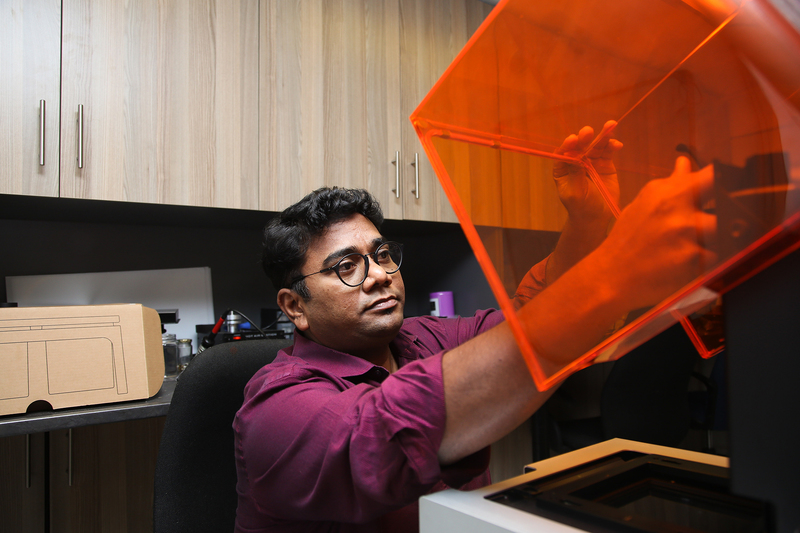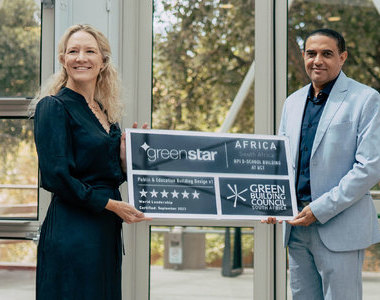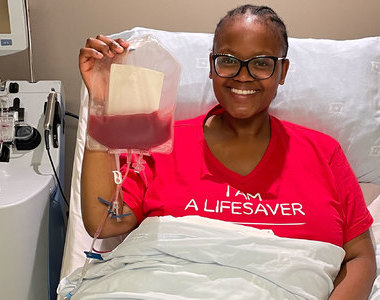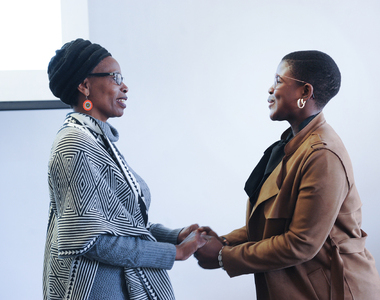When crisis cultivates collaboration
10 June 2020 | Story Nadia Krige. Photo Supplied. VoiceM Nash Makado. Read time 10 min.
One way of viewing a crisis is as an opportunity to pursue and contribute to a better future. For Associate Professor Sudesh Sivarasu and his team of biomedical engineers at the University of Cape Town (UCT), COVID-19 has brought just that: the opportunity to serve the greater good through collaboration and sharing of knowledge.
“With COVID-19, our team’s philosophy has been to collaborate closely with other innovators in an effort to create technologies that are appropriate to our African context,” says Sivarasu, an associate professor of biomedical engineering in the Faculty of Health Sciences at UCT.
“The idea is to work together for the benefit of the larger population … and facilitate open-source innovations.”
“... it’s not a time to buckle to the pressure, but rather to be creative and innovative in the way we approach and solve this problem.”
Innovation tailored to Africa
In response to the unfolding coronavirus crisis, Sivarasu and his team have been working on a variety of biomedical devices, including a face shield that can be made easily with household items.
The devices they’ve chosen to dedicate their resources to have been informed by public as well as clinical need and are based on designs proven to be successful in other parts of the world.
“We’ve been somewhat fortunate here in South Africa, as COVID-19 hit us at least a month later than many other countries,” explains Sivarasu. “This means that we could watch ‘the wheel being invented’ elsewhere – seeing both the successes and the failures.”
This close observation has also enabled Sivarasu, his team and other local researchers to take a more focused and careful approach to their own innovations. In essence, they are adopting and adapting ‘the wheel’ rather than reinventing it.
UCT ViZARs
The ViZAR is among the first of the team’s COVID-19 solutions to have been approved by the South African Health Products Regulatory Authority (SAHPRA). It acts as a first line of defence between the user and any infectious, airborne particles.
In addition to offering protection against harmful aerosols, it also prevents users from touching their faces and the possible cross-contamination this can cause.
The ViZAR was designed by postgraduate researcher Matthew Trusler, from the Division of Biomedical Engineering, in collaboration with Sivarasu, as well as Dr Stephen Roche of the UCT Division of Orthopaedic Surgery, Professor Salome Maswime and Dr Tracey Adams of the UCT Division of Global Surgery, and Saberi Marais from UCT Research Contracts & Innovation.
“We feel that it is almost an essential item,” says Sivarasu.
To ensure maximum comfort for the user, the team focused on user-centred features, such as a shield transparent enough to prevent claustrophobia, foam lining along the top of the visor that conforms to the user’s forehead, and establishing the perfect length and width of elastic to minimise pressure. (Around 40 centimetres long and at least 2.5 centimetres wide seems to be the sweet spot; a conclusion arrived at after more than a dozen iterations.)
In the lead up to approval by SAHPRA, the engineers ran risk assessments, including asking clinicians such as Roche and Maswime to wear the ViZAR and provide detailed feedback. They then refined the design accordingly.
Since being approved, the team has already manufactured over 13 000 of these ViZARs and are in the process of making another 20 000. They aim to raise funds for another 100 000 units in the next couple of months.
So far, thanks to funding from the Willis Foundation and the Harry & Doris Crossley Foundations, they have donated 2 000 ViZARs to Groote Schuur Hospital, 5 000 to the Western Cape Department of Health, and 500 to District Six Community Health Centre – with more donations to follow.
Making the ViZAR
An important aspect of the ViZAR design is that for manufacture – instead of going the 3D-printing route widely favoured elsewhere – the UCT team opted for a hand-made approach, using products that are easily available to make them more accessible. This allowed the team to scale their production to the order of a few 1 000 ViZARs a day, facilitating job creation through a sustainable and local supply chain.
“The UCT ViZAR project started off as a response to the overwhelming need to protect our clinicians and health workers against the tide of COVID-19 infections and quickly turned into an in-depth look at why the current solutions weren’t working,” says Trusler.
“We hope to reach as many South Africans as we can with all of our technologies from the Medical Devices Lab, and this is certainly a step in the right direction.”
To make a ViZAR requires materials like an overhead projector transparency, elastic, foam and double-sided tape. All in all, a simplified DIY mask can be made according to the UCT ViZAR specifications with materials costing no more than ZAR10.
Clearing obstacles to collaboration
“For us, Covid-19 has truly opened boundaries to collaboration,” muses Sivarasu. “Everybody has been very willing to share knowledge and work together.”
The Central University of Technology (CUT) in Bloemfontein has stepped up as the manufacturing partner for the medical grade ViZARs, providing ISO 13485 quality management, which is required for the manufacture of medical devices.
“As our official manufacturing partners for the UCT ViZAR, the contributions of CUT’s team – headed by Dr Gerrie Booysen – have been invaluable,” says Sivarasu. “This is also just the beginning of much larger collaborations across higher education institutions in South Africa.”
“For us, Covid-19 has truly opened boundaries to collaboration.”
Not without challenges
While the coronavirus crisis has opened-up a wealth of opportunities for Africa-centric innovation and collaboration, it’s also highlighted some of the most pertinent challenges for the continent’s innovators.
“If you wanted to narrow it down to one particular challenge, it would be supply-chain issues,” explains Sivarasu.
Being heavily reliant on material coming from abroad – especially China and elsewhere in the east – African innovators have had to turn their attention to what’s available locally and will have to continue doing so for the foreseeable future.
“Now that this is a challenge, it’s not a time to buckle to the pressure, but rather to be creative and innovative in the way we approach and solve this problem.”
Finally, the crisis has also served as something of a wake-up call for academia to become more agile and dynamic in their approach to projects.
“There is a complete mindset change that needs to happen,” he says. “It’s a choice, right? If you really want to contribute to society, you’ve got to break that barrier.”
 This work is licensed under a Creative Commons Attribution-NoDerivatives 4.0 International License.
This work is licensed under a Creative Commons Attribution-NoDerivatives 4.0 International License.
Please view the republishing articles page for more information.
Listen to the news
The stories in this selection include an audio recording for your listening convenience.























































































































































































































































































































































































